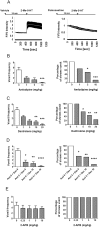Serotonin 5-HT3 receptor-mediated vomiting occurs via the activation of Ca2+/CaMKII-dependent ERK1/2 signaling in the least shrew (Cryptotis parva)
- PMID: 25121483
- PMCID: PMC4133232
- DOI: 10.1371/journal.pone.0104718
Serotonin 5-HT3 receptor-mediated vomiting occurs via the activation of Ca2+/CaMKII-dependent ERK1/2 signaling in the least shrew (Cryptotis parva)
Abstract
Stimulation of 5-HT3 receptors (5-HT3Rs) by 2-methylserotonin (2-Me-5-HT), a selective 5-HT3 receptor agonist, can induce vomiting. However, downstream signaling pathways for the induced emesis remain unknown. The 5-HT3R channel has high permeability to extracellular calcium (Ca(2+)) and upon stimulation allows increased Ca(2+) influx. We examined the contribution of Ca(2+)/calmodulin-dependent protein kinase IIα (Ca(2+)/CaMKIIα), interaction of 5-HT3R with calmodulin, and extracellular signal-regulated kinase 1/2 (ERK1/2) signaling to 2-Me-5-HT-induced emesis in the least shrew. Using fluo-4 AM dye, we found that 2-Me-5-HT augments intracellular Ca(2+) levels in brainstem slices and that the selective 5-HT3R antagonist palonosetron, can abolish the induced Ca(2+) signaling. Pre-treatment of shrews with either: i) amlodipine, an antagonist of L-type Ca(2+) channels present on the cell membrane; ii) dantrolene, an inhibitor of ryanodine receptors (RyRs) Ca2+-release channels located on the endoplasmic reticulum (ER); iii) a combination of their less-effective doses; or iv) inhibitors of CaMKII (KN93) and ERK1/2 (PD98059); dose-dependently suppressed emesis caused by 2-Me-5-HT. Administration of 2-Me-5-HT also significantly: i) enhanced the interaction of 5-HT3R with calmodulin in the brainstem as revealed by immunoprecipitation, as well as their colocalization in the area postrema (brainstem) and small intestine by immunohistochemistry; and ii) activated CaMKIIα in brainstem and in isolated enterochromaffin cells of the small intestine as shown by Western blot and immunocytochemistry. These effects were suppressed by palonosetron. 2-Me-5-HT also activated ERK1/2 in brainstem, which was abrogated by palonosetron, KN93, PD98059, amlodipine, dantrolene, or a combination of amlodipine plus dantrolene. However, blockade of ER inositol-1, 4, 5-triphosphate receptors by 2-APB, had no significant effect on the discussed behavioral and biochemical parameters. This study demonstrates that Ca(2+) mobilization via extracellular Ca(2+) influx through 5-HT3Rs/L-type Ca(2+) channels, and intracellular Ca(2+) release via RyRs on ER, initiate Ca(2+)-dependent sequential activation of CaMKIIα and ERK1/2, which contribute to the 5-HT3R-mediated, 2-Me-5-HT-evoked emesis.
Conflict of interest statement
Figures










Similar articles
-
L-type calcium channels contribute to 5-HT3-receptor-evoked CaMKIIα and ERK activation and induction of emesis in the least shrew (Cryptotis parva).Eur J Pharmacol. 2015 May 15;755:110-8. doi: 10.1016/j.ejphar.2015.02.042. Epub 2015 Mar 5. Eur J Pharmacol. 2015. PMID: 25748600
-
Thapsigargin-induced activation of Ca(2+)-CaMKII-ERK in brainstem contributes to substance P release and induction of emesis in the least shrew.Neuropharmacology. 2016 Apr;103:195-210. doi: 10.1016/j.neuropharm.2015.11.023. Epub 2015 Nov 26. Neuropharmacology. 2016. PMID: 26631534
-
Intracellular emetic signaling evoked by the L-type Ca2+ channel agonist FPL64176 in the least shrew (Cryptotis parva).Eur J Pharmacol. 2018 Sep 5;834:157-168. doi: 10.1016/j.ejphar.2018.06.035. Epub 2018 Jun 30. Eur J Pharmacol. 2018. PMID: 29966616 Free PMC article.
-
Ca2+ signaling and emesis: Recent progress and new perspectives.Auton Neurosci. 2017 Jan;202:18-27. doi: 10.1016/j.autneu.2016.07.006. Epub 2016 Jul 26. Auton Neurosci. 2017. PMID: 27473611 Review.
-
Mechanism of the anti-emetic activity of 5-HT3 receptor antagonists.Oncology. 1992;49(4):263-8. doi: 10.1159/000227054. Oncology. 1992. PMID: 1387926 Review.
Cited by
-
Mechanisms of Nausea and Vomiting: Current Knowledge and Recent Advances in Intracellular Emetic Signaling Systems.Int J Mol Sci. 2021 May 28;22(11):5797. doi: 10.3390/ijms22115797. Int J Mol Sci. 2021. PMID: 34071460 Free PMC article. Review.
-
Intracellular emetic signaling cascades by which the selective neurokinin type 1 receptor (NK1R) agonist GR73632 evokes vomiting in the least shrew (Cryptotis parva).Neurochem Int. 2019 Jan;122:106-119. doi: 10.1016/j.neuint.2018.11.012. Epub 2018 Nov 16. Neurochem Int. 2019. PMID: 30453005 Free PMC article.
-
Acoustic white noise ameliorates reduced regional brain expression of CaMKII and ΔFosB in the spontaneously hypertensive rat model of ADHD.IBRO Rep. 2018 Dec 4;6:31-39. doi: 10.1016/j.ibror.2018.11.007. eCollection 2019 Jun. IBRO Rep. 2018. PMID: 30656238 Free PMC article.
-
RNA sequencing least shrew (Cryptotis parva) brainstem and gut transcripts following administration of a selective substance P neurokinin NK1 receptor agonist and antagonist expands genomics resources for emesis research.Front Genet. 2023 Feb 14;14:975087. doi: 10.3389/fgene.2023.975087. eCollection 2023. Front Genet. 2023. PMID: 36865388 Free PMC article.
-
Role of PI3K/Akt/GSK-3 Pathway in Emesis and Potential New Antiemetics.J Cell Signal. 2020 Dec;1(4):155-159. doi: 10.33696/Signaling.1.024. J Cell Signal. 2020. PMID: 33426544 Free PMC article. No abstract available.
References
-
- Darmani NA, Ray AP (2009) Evidence for a re-evaluation of the neurochemical and anatomical bases of chemotherapy-induced vomiting. Chem Rev 109: 3158–3199. - PubMed
-
- MS Al-Tikriti WK, Chebolu S (2012) Distribution of Serotonin-immunoreactive Enterochromaffin Cells in the Gastrointestinal Tract of the Least Shrew (Cryptotis parva).
-
- Endo T, Minami M, Kitamura N, Teramoto Y, Ogawa T, et al. (1999) Effects of various 5-HT3 receptor antagonists, granisetron, ondansetron, ramosetron and azasetron on serotonin (5-HT) release from the ferret isolated ileum. Res Commun Mol Pathol Pharmacol 104: 145–155. - PubMed
Publication types
MeSH terms
Substances
LinkOut - more resources
Full Text Sources
Other Literature Sources
Medical
Miscellaneous

